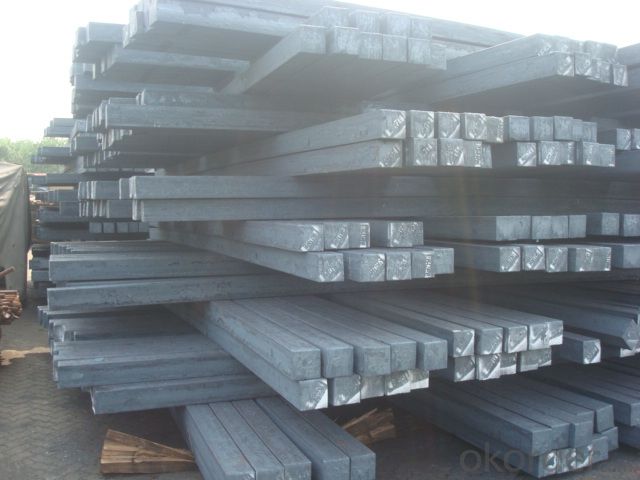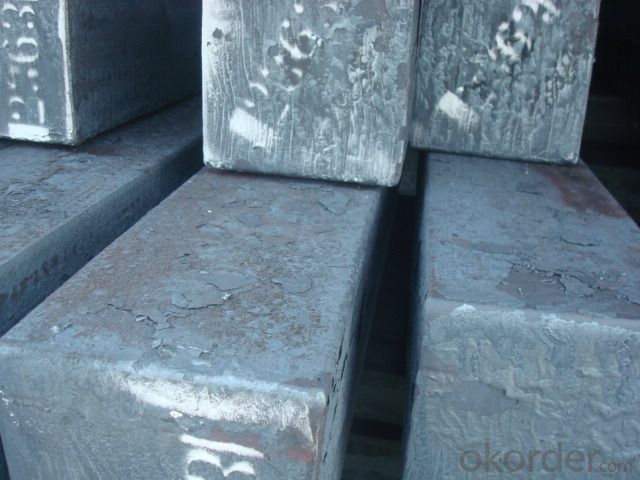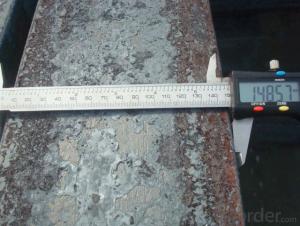Steel Billet Manufactured by Blast Furnace without Boron
- Loading Port:
- Tianjin
- Payment Terms:
- TT OR LC
- Min Order Qty:
- 1000 m.t.
- Supply Capability:
- 100000 m.t./month
OKorder Service Pledge
OKorder Financial Service
You Might Also Like
Steel Billet Manufactured by Blast Furnace without Boron
1.Structure of Steel Billet Manufactured by Blast Furnace without Boron
Steel Billet Manufactured by Blast Furnace without Boron is the raw material of all kinds of steel mill. Billet section of square, round, flat, rectangular and abnormity, etc Several, mainly related to shape of rolled products. Simple rolled section steel, choose cross section of square billet or rectangular billet. rolling The sector products such as flat steel, Angle steel, select the rectangular billet or slab. Had better profiled billet when production beams, channels, and in rolling process Lines and improve the yield. The raw material of round billet is the production of seamless tube.
2.Main Features of Steel Billet Manufactured by Blast Furnace without Boron.
Steel Billet Manufactured by Blast Furnace without Boron section size should meet the requirements of rolling deformation and finished product quality, but also roll strength and biting condition of restrictions. General steel Billet section height H. And the roll diameter D The ratio of the ( namely H/D) Should be less than or equal to zero 0.5 . Length of steel billet by finishing temperature, Rolling time and the length of the product Or times ruler. When heated too long accident prone to bump the furnace wall of steel, too short, furnace bottom utilization rate is not high, influence the heating furnace production. For the production Choose a variety of steel and steel billet, should consider the affinities of billet, as far as possible in order to improve the productivity of the roughing mill, simplify the stock management of workshop.
3. Steel Billet Manufactured by Blast Furnace without Boron Images


4. Steel Billet Manufactured by Blast Furnace without Boron Specification
Steel Billet Manufactured by Blast Furnace without Boron rolled steel, after processing can be used for mechanical parts, forging parts, processing all kinds of steel, steel Q345B channel steel, wire rod is the role of the billet. Steel billet is used in the production of semi-finished products, generally cannot be used directly for the society. Steel billets and steel are strictly divided into standard, cannot decide to whether the business enterprise of the final product, and according to unified standards to perform the whole society. Typically, billet and the steel is relatively easy to distinguish, but for some steel billet, and have the same specification and same steel purposes (such as rolling tube billet), whether can be used for other industries, whether through steel processing process, whether through a finished product rolling mill processing to distinguish
The classification of the Bloom Mainly from the shape is divided into two kinds: Slab: cross section width and height of the ratio of the larger, mainly used for rolling plate. Bloom: equal cross section width and height, or a huge difference, mainly used for rolling steel, wire rod.
Bloom material standard The thickness range: 150-240 - mm + / - 5 mm The width of the range: 880-1530 - mm + / - 20 mm Length range: 3700-10000 - mm + / - 500 - mm Cross-sectional size: 64 * 64 ; 82 * 82 ; 98 * 98 ; 124 * 124 ; 120 * 150 ; 152 * 164 ; 152 * 170 mm Length: 9000 mm The section of tolerance: Bloom: 1.0 + / - 2.0-1.0 + / - 1.0 mm The slab width: + / - 2.0 MM ; Thickness: + / - 3.0 MM
5.FAQ of Steel Billet Manufactured by Blast Furnace without Boron
We have organized several common questions for our clients,may help you sincerely:
①How about your company?
A world class manufacturer & supplier of castings forging in carbon steel and alloy steel,is one of the large-scale professional investment casting production bases in China,consisting of both casting foundry forging and machining factory. Annually more than 8000 tons Precision casting and forging parts are exported to markets in Europe,America and Japan. OEM casting and forging service available according to customer’s requirements.
②How to guarantee the quality of the products?
We have established the international advanced quality management system,every link from raw material to final product we have strict quality test;We resolutely put an end to unqualified products flowing into the market. At the same time, we will provide necessary follow-up service assurance.
③How is the packaging and delivery?
Exporting Package with the steel material cover and the delivery term is based on the project.
- Q:What are the different types of cutting processes used for shaping steel billets?
- There are several different types of cutting processes used for shaping steel billets, including sawing, shearing, and flame cutting. Sawing involves using a saw blade to cut through the billet, while shearing uses a machine with two blades to cut the billet in a straight line. Flame cutting, on the other hand, involves using a high-temperature flame to melt and cut through the steel. Each process has its own advantages and is chosen based on factors such as the desired accuracy, speed, and cost-effectiveness of the cutting operation.
- Q:How are steel billets inspected before they are used in production?
- Steel billets are inspected before they are used in production through a rigorous quality control process. This typically includes visual inspection to check for surface defects and dimensional accuracy. Additionally, non-destructive testing techniques such as ultrasonic testing or magnetic particle inspection are employed to detect internal flaws or cracks. Chemical analysis is performed to ensure the steel composition meets the required specifications. These inspections help ensure the integrity and quality of the billets before they are used in production.
- Q:Are steel billets used in the production of construction equipment?
- Yes, steel billets are commonly used in the production of construction equipment. Steel billets are semi-finished steel products that are typically hot-rolled or forged into various shapes and sizes. These billets serve as the raw material for manufacturing construction equipment components, such as beams, plates, rods, and structural parts. The use of steel billets in construction equipment ensures the durability, strength, and reliability of the final product, making it suitable for heavy-duty applications in the construction industry.
- Q:What are the different shapes and sizes of steel billets?
- Steel billets come in various shapes and sizes, including square, round, rectangular, and hexagonal. The sizes of steel billets can range from small dimensions, such as 100mm x 100mm, to larger dimensions, such as 400mm x 400mm. These different shapes and sizes of steel billets serve different purposes and can be used in various industries, including construction, manufacturing, and automotive.
- Q:How do steel billets contribute to the manufacturing of agricultural equipment?
- Due to their versatility and durability, steel billets are essential for the manufacturing of agricultural equipment. These semi-finished steel products serve as the foundation for various agricultural machinery. To begin with, steel billets are crucial for creating the main structural components of agricultural equipment, including tractors, harvesters, plows, and tillers. These components, such as the chassis, frame, and axles, require a strong and sturdy material to withstand the heavy loads and harsh conditions encountered in agricultural operations. Steel billets provide the necessary strength and resilience to ensure the equipment's ability to endure the rigors of farming. Moreover, steel billets are used to manufacture smaller parts and mechanisms that are vital to the functioning of agricultural machinery. Gears, sprockets, shafts, and bearings, for instance, are commonly made from steel billets. These parts play a crucial role in transmitting power and facilitating the smooth operation of various agricultural equipment. Additionally, steel billets contribute to the longevity and reliability of agricultural equipment. The high strength and durability of steel ensure that the machinery can withstand the demanding agricultural environment, including exposure to moisture, dirt, and extreme temperatures. This durability reduces maintenance requirements and extends the equipment's lifespan, resulting in cost savings for farmers. Furthermore, steel billets offer the advantage of being easily shaped and molded into complex designs. This enables manufacturers to create customized agricultural equipment tailored to specific farming needs. The flexibility in design allows for the production of specialized machinery for various agricultural operations, such as planting, harvesting, irrigation, and livestock management. In conclusion, steel billets are indispensable in the manufacturing of agricultural equipment as they provide the necessary strength, durability, and versatility required for the demanding conditions of modern farming. Their contribution ensures that farmers have access to reliable and efficient machinery, ultimately increasing productivity and supporting sustainable agricultural practices.
- Q:How are steel billets used in the manufacturing of industrial valves?
- Steel billets are used in the manufacturing of industrial valves as they serve as the raw material for forging and shaping various valve components, such as the body, bonnet, and stem. These billets are heated, and through a process called hot forging, they are transformed into the desired shape and size of the valve parts. The use of steel billets ensures the strength, durability, and integrity of the valves, making them suitable for demanding industrial applications.
- Q:How are steel billets sheared into smaller sections?
- Using a mechanical technique called shearing, steel billets are cut into smaller sections. This procedure involves the utilization of a shearing machine equipped with a specific sharp blade or blades designed for cutting through the steel billet. Firstly, the steel billet is placed on a sturdy cutting table, and then the shearing machine is activated. With considerable force, the blade(s) of the machine are brought down onto the steel billet, effectively slicing through the material and separating it into smaller sections. Depending on the shearing machine's particular design, the blade(s) may move vertically, horizontally, or in a combination of both. To ensure a clean and precise cut, it is common practice to securely clamp the steel billet in place before commencing the shearing process. This precaution minimizes any potential movement or shifting of the material during cutting, which could lead to an uneven or inaccurate cut. Additionally, the blade(s) of the shearing machine are usually made from high-speed steel or another durable and sharp material to ensure efficient cutting and prolonged use. In conclusion, the shearing process is a highly efficient and effective method for dividing steel billets into smaller sections. It enables precise control over size and shape, making it an invaluable technique in numerous industries that utilize steel products.
- Q:How do steel billets contribute to the manufacturing of medical equipment?
- The manufacturing of medical equipment is greatly aided by steel billets. Various components of medical equipment are produced using steel billets as the raw material. These billets are melted and then formed into tubes, rods, or sheets, which are subsequently utilized to create essential parts of medical equipment. For example, scalpels, forceps, and scissors, which require precision and durability, are commonly manufactured using steel billets. Steel's strength and resistance to corrosion make it the ideal material for these instruments. By melting and shaping steel billets into specific forms, the reliability and longevity of these instruments are ensured. Furthermore, medical implants such as hip replacements, knee replacements, and dental implants require materials that are biocompatible, strong, and resistant to wear. Steel billets, especially stainless steel, fulfill these requirements and are employed in the creation of implants that enhance the quality of life for many patients. In addition, steel billets contribute to the manufacturing of medical equipment by providing the framework for devices like hospital beds, surgical tables, and examination tables. These structures need to be sturdy, stable, and capable of supporting the weight of patients. Steel billets are transformed into various shapes and sizes to construct the frames and bases of these equipment, ensuring their robustness and reliability. To summarize, steel billets play a vital role in the manufacturing of medical equipment. They serve as the raw material, which is melted, shaped, and converted into components, instruments, and structures necessary for the production of surgical instruments, implants, and medical devices. The strength, durability, and corrosion resistance of steel make it an ideal material for manufacturing medical equipment that meets the stringent standards of the healthcare industry.
- Q:Can steel billets be cold rolled?
- No, steel billets cannot be cold rolled. Cold rolling is a process that involves passing metal through rollers at room temperature to achieve a desired thickness and surface finish. Steel billets, on the other hand, are semi-finished metal products that are hot rolled into specific shapes.
- Q:What are the potential applications of steel billets in the transportation aftermarket?
- Steel billets have a wide range of potential applications in the transportation aftermarket. One of the main uses of steel billets in this industry is for the production of various components and parts for vehicles. These billets can be used to manufacture engine parts, suspension components, steering parts, and other critical components that require strength and durability. Steel billets can also be used in the manufacturing of structural components for vehicles, such as chassis frames and body panels. The high strength and rigidity of steel make it an ideal material for these applications, as it can withstand the stresses and strains experienced during vehicle operation. Furthermore, steel billets can be utilized in the production of wheels and rims for automobiles, motorcycles, and even bicycles. The superior strength and ability to withstand heavy loads make steel billets a preferred choice for wheel manufacturing, ensuring safety and reliability on the road. In addition to vehicle components and parts, steel billets can also be used in the production of rail tracks and infrastructure for railways. The strength and durability of steel make it an ideal material for rail tracks, ensuring safe and efficient transportation of goods and passengers. Overall, the potential applications of steel billets in the transportation aftermarket are vast and diverse. From manufacturing critical vehicle components to building infrastructure for railways, steel billets play a crucial role in ensuring the efficiency, safety, and reliability of transportation systems.
1. Manufacturer Overview |
|
|---|---|
| Location | |
| Year Established | |
| Annual Output Value | |
| Main Markets | |
| Company Certifications | |
2. Manufacturer Certificates |
|
|---|---|
| a) Certification Name | |
| Range | |
| Reference | |
| Validity Period | |
3. Manufacturer Capability |
|
|---|---|
| a)Trade Capacity | |
| Nearest Port | |
| Export Percentage | |
| No.of Employees in Trade Department | |
| Language Spoken: | |
| b)Factory Information | |
| Factory Size: | |
| No. of Production Lines | |
| Contract Manufacturing | |
| Product Price Range | |
Send your message to us
Steel Billet Manufactured by Blast Furnace without Boron
- Loading Port:
- Tianjin
- Payment Terms:
- TT OR LC
- Min Order Qty:
- 1000 m.t.
- Supply Capability:
- 100000 m.t./month
OKorder Service Pledge
OKorder Financial Service
Similar products
New products
Hot products
Related keywords





























